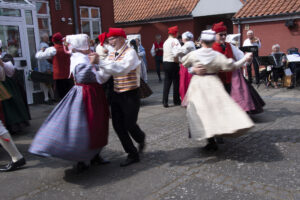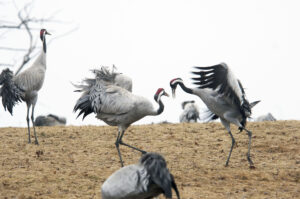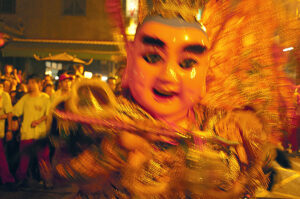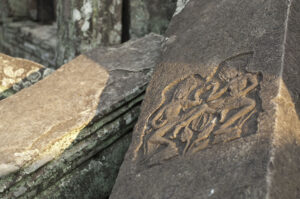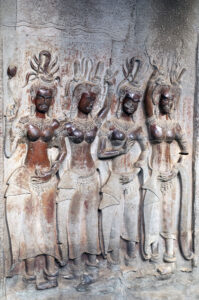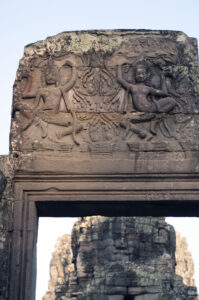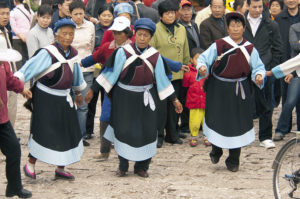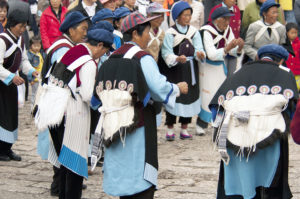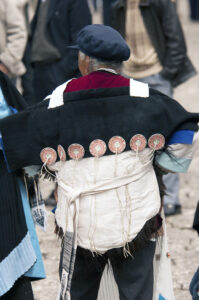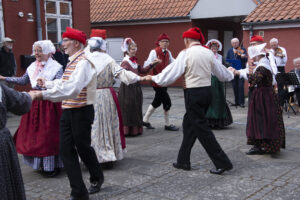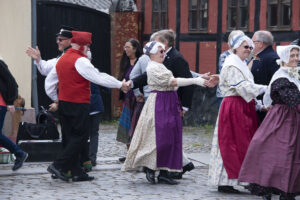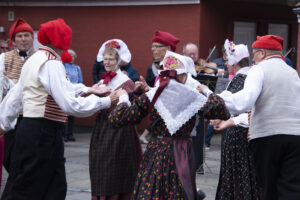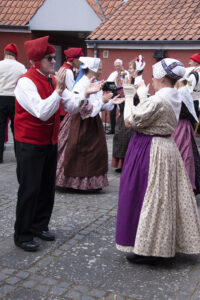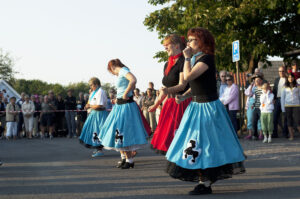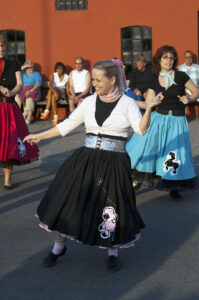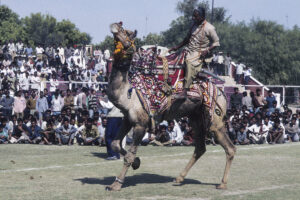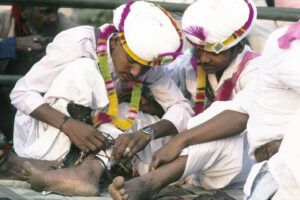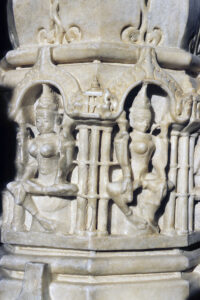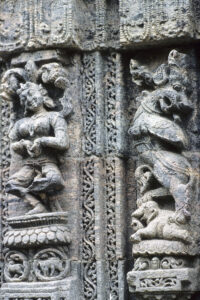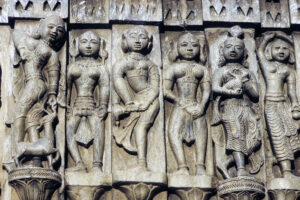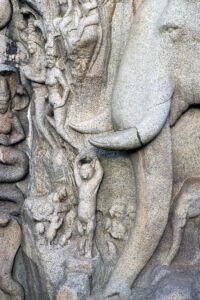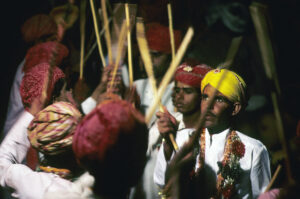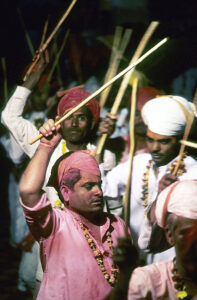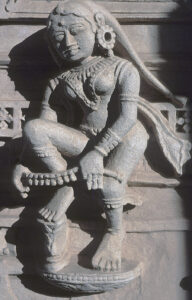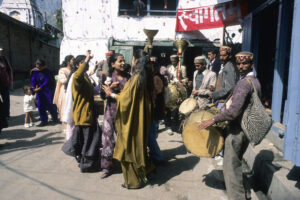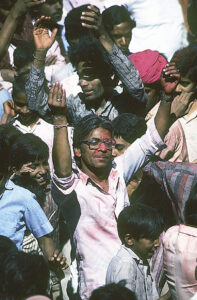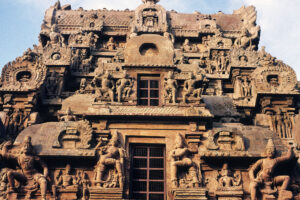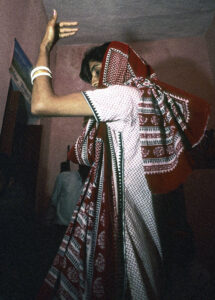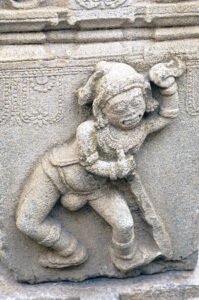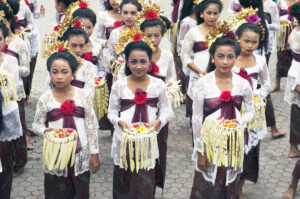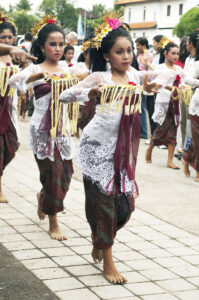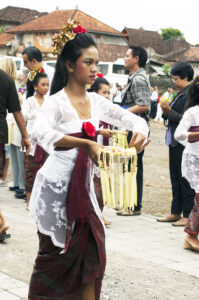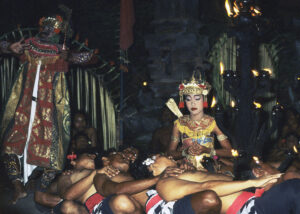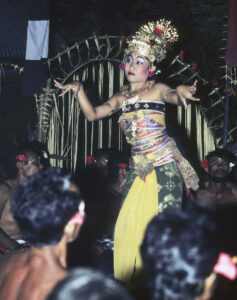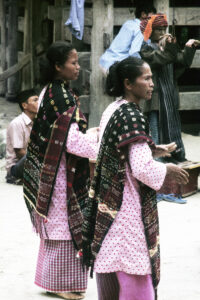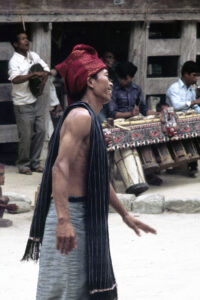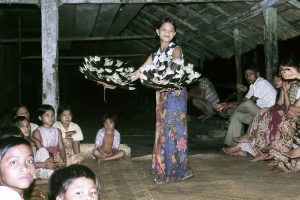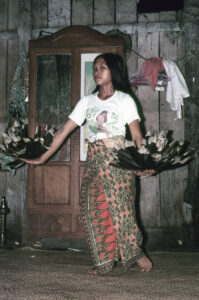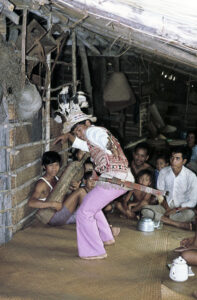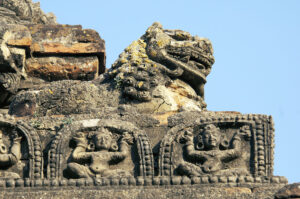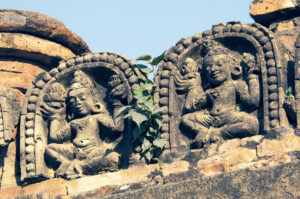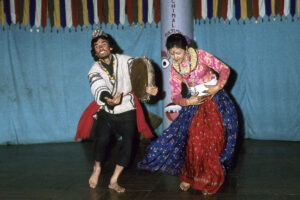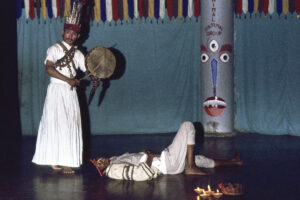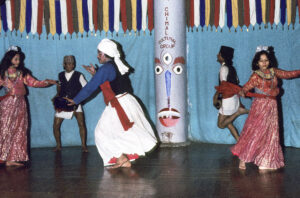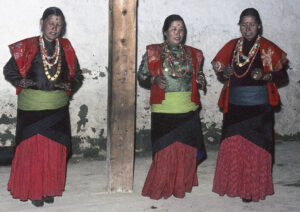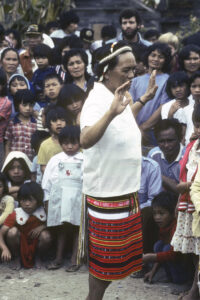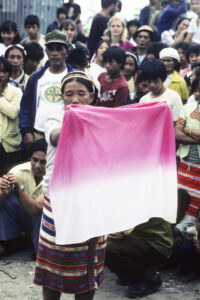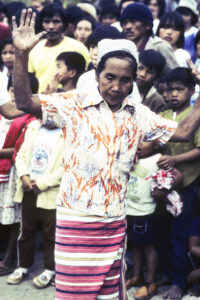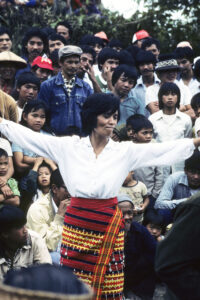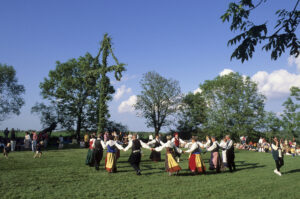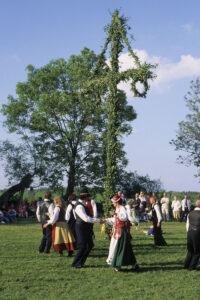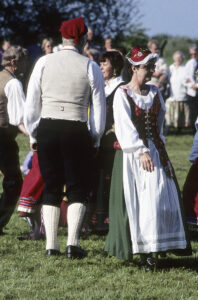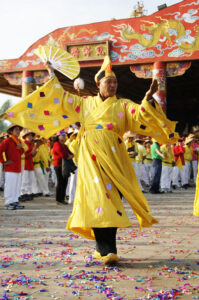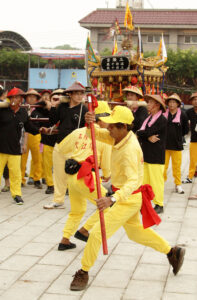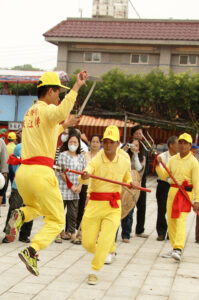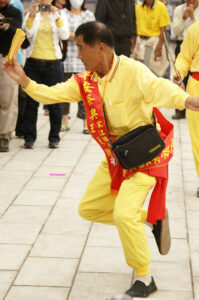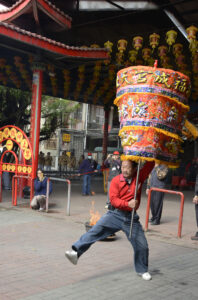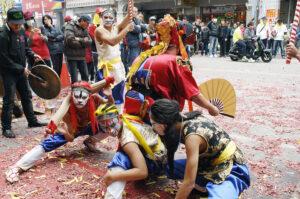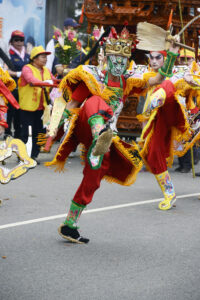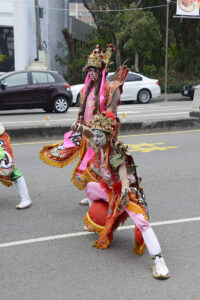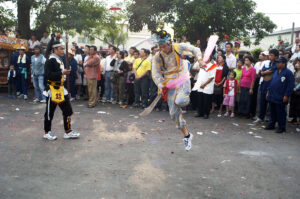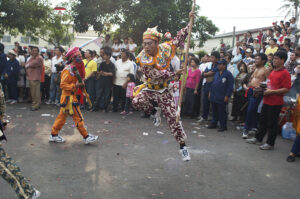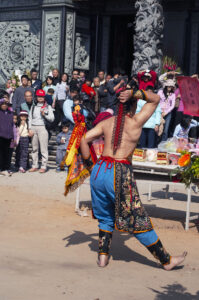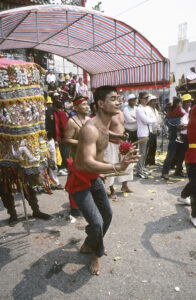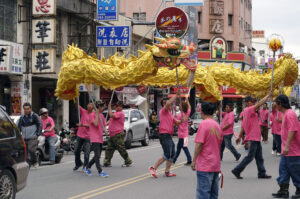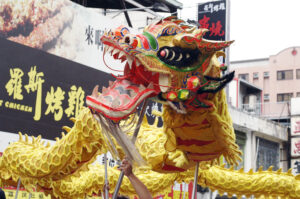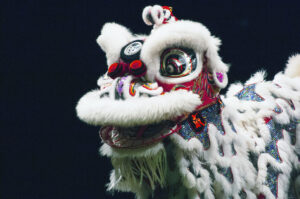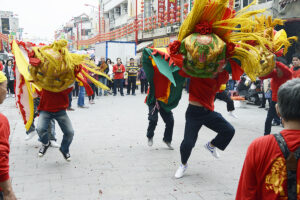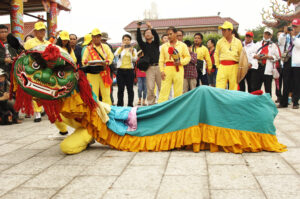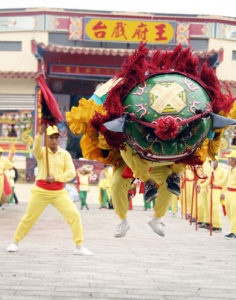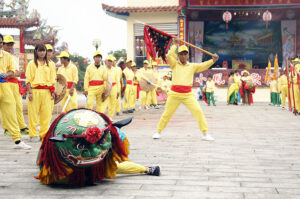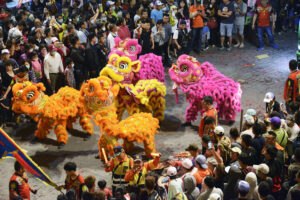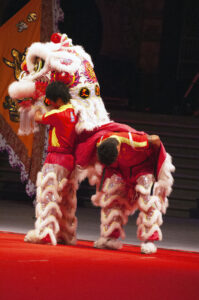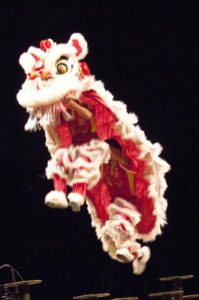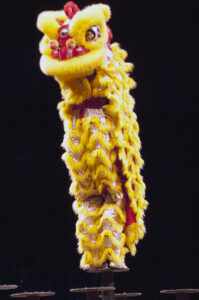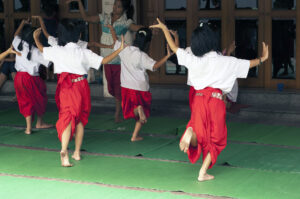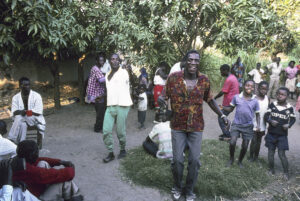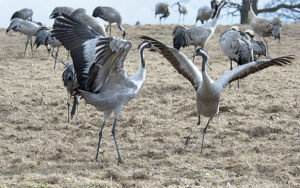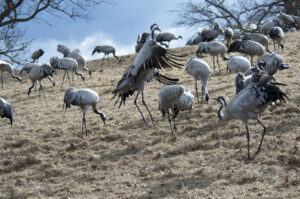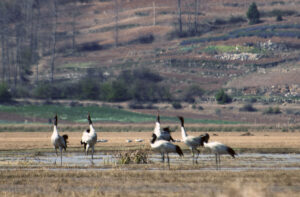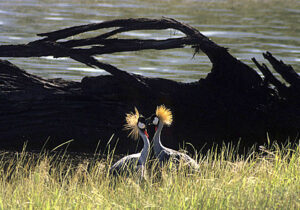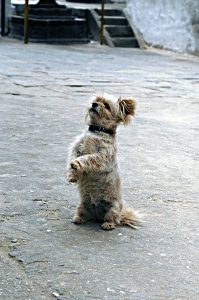Dancing
On the Danish island of Bornholm, these dancers, wearing traditional dresses, perform old-time dances in the town of Aakirkeby. (Photo copyright © by Kaj Halberg)
Dancing common cranes (Grus grus), Hornborgasjön, Sweden. (Photo copyright © by Kaj Halberg)
Dressed as one of the legendary San-tai-tze (‘Three Princes’), this man is dancing during a Daoist festival, dedicated to the supreme Mother Goddess Mazu, taking place in Changhua, Taiwan. (Photo copyright © by Kaj Halberg)
This Khmer relief on an overturned stelae at Angkor Thom, Cambodia, may depict apsaras, also called Daughters of Joy – supernatural female beings, who are superb in the art of dancing. (Photo copyright © by Kaj Halberg)
Dancing has undoubtedly existed almost as long as humans have existed, and, over time, it has evolved into countless forms.
On this page, I have also included various animal species that perform dances.
Cambodia
The Khmer Empire was a Southeast Asian Hindu kingdom, which left a superb legacy in the form of the Angkor Wat ruins, in present-day Cambodia. Judging from the many reliefs of dancers, male as well as female, dancing seemed to be a prominent means of entertainment at the Khmer royal court. Many of the reliefs possibly depict apsaras, also called Daughters of Joy – supernatural female beings, who are superb in the art of dancing. They are often depicted dancing to music, delivered by Gandharvas, court musicians of the rain god Indra. They entertain and sometimes seduce gods and men.
This Khmer relief at Angkor Wat possibly depicts Hindu god Vishnu and his female consort Lakshmi. The seven-headed cobra Shesha, which is seen in the centre and to the left, is protector of Vishnu. (Photo copyright © by Kaj Halberg)
This relief at Angkor Wat depicts a male dancer. (Photo copyright © by Kaj Halberg)
This relief at Angkor Wat depicts female court dancers, presumably apsaras. (Photo copyright © by Kaj Halberg)
This relief on an entrance gate at Angkor Thom depicts a male and a female dancer. In the background, large stone blocks have been carved and fitted together to form a face, depicting Lokesvara, a great Khmer king. (Photo copyright © by Kaj Halberg)
China
Wearing traditional dresses, these women of the Nakhi people perform a dance, Lijiang, Yunnan Province. (Photos copyright © by Kaj Halberg)
Denmark
On the island of Bornholm, these dancers, wearing traditional dresses, perform old-time dances in the town of Aakirkeby. (Photos copyright © by Kaj Halberg)
Line dance performance, Snogebæk, Bornholm. (Photos copyright © by Kaj Halberg)
India
Music and dancing camels constitute a part of the entertainment during a so-called camel festival, taking place in the town of Bikaner, Thar Desert, Rajasthan. (Photo copyright © by Kaj Halberg)
During the camel festival in Bikaner, this dancer is tying bells around the ankles of a fellow dancer. (Photo copyright © by Kaj Halberg)
These carvings on a white marble pillar in the Jain temple Vimal Vasahi, Dilwara, Mount Abu, Rajasthan, depict female dancers. (Photo copyright © by Kaj Halberg)
These reliefs in the Sun Temple, Konark, Odisha (Orissa), depict a female dancer, and a huge monster, trampling an elephant. (Photo copyright © by Kaj Halberg)
This frieze in the Hindu temple Jagdish, Udaipur, Rajasthan, depicts female dancers. This temple, dedicated to the god Vishnu, was erected around 1651. (Photo copyright © by Kaj Halberg)
At the outskirts of the town of Mamallapuram, Tamil Nadu, numerous sculptures, altogether measuring about 15 by 30 m, have been carved into two boulders. The main theme of these sculptures, which has been dubbed The Descent of the Ganges, is an event in the Hindu epic Mahabharatha. Bhagiratha was a great king, doing penance for a thousand years to obtain the release of his 60,000 great-uncles from the curse of Saint Kapila, eventually leading to the descent of the goddess Ganga to Earth, in the form of River Ganges.
Dancing cat below an elephant, a detail of ‘The Descent of the Ganges’. (Photo copyright © by Kaj Halberg)
During Hindu New Year, these men perform a stick dance, Seventri, Rajasthan. (Photos copyright © by Kaj Halberg)
This carving in the Jain temple atop the Shetrunjaya Hill, near Palitana, Gujarat, depicts a female dancer, tying bells around her ankles. (Photo copyright © by Kaj Halberg)
In Hindu mythology, Mahishasura was a powerful demon, who threatened to usurp the gods, and not even the mighty Vishnu and Shiva could resist him. But then the powerful goddess Durga went into action. Riding on her lion, she attacked Mahishasura, who changed into a huge buffalo, then into a lion. Durga sliced off his head, but he then changed into an elephant, whereupon Durga cut off his trunk. In spite of the demon hurling large mountains at the goddess, she managed to kill him with her spear.
During the festival of Dassera, or Durga Puja, people in the city of Kullu, Himachal Pradesh, celebrate Durga’s victory over Mahishasura with music and dancing. (Photo copyright © by Kaj Halberg)
During Hindu New Year, this man performs a dance in front of a Hanuman temple in the town of Charbhuja, Rajasthan. (Photo copyright © by Kaj Halberg)
A gopura, or gopuram, is an entrance tower, leading into a Hindu temple or temple complex. Such towers are usually extravagantly adorned with carvings. Pictures, depicting such gopuras, are found on the pages Religion: Hinduism, and Entrances.
Numerous dancers are depicted on this gopuram in the Brihadisvara Temple, Thanjavur, Tamil Nadu. (Photo copyright © by Kaj Halberg)
Dancing Hindu woman, Udaipur, Rajasthan. (Photo copyright © by Kaj Halberg)
This relief, depicting a dancing clown, is found in a temple atop the mountain Vindyagiri, Sravanabelagola, Karnataka, dedicated to the Jain saint Bahubali (Gomateswara). This temple is described in depth on the page Religion: Jainism. (Photo copyright © by Kaj Halberg)
Indonesia
Girls, dressed in their finery for a dancing performance during a Hindu temple festival, near Ubud, Bali. (Photos copyright © by Kaj Halberg)
A story from the Hindu epic Ramayana relates, how Sita, wife of Rama, the 7th avatar (incarnation) of the mighty god Vishnu, was abducted by Ravana, a 10-headed and 20-armed demon king from Sri Lanka. Hanuman, leader of the monkey army, which supported Rama, went to Sri Lanka to negotiate Sita’s release.
In this scene from the Balinese Keçak Dance, or Monkey Dance, Sita performs a dance for Hanuman’s monkey army. The dancer to the left performs as the demon king Ravana. – Ubud, Bali. (Photos copyright © by Kaj Halberg)
The Batak are a group of closely related Austronesian peoples, including the Karo, Pakpak, Simalungun, Toba, Angkola, and Mandailing, who live in a large area of northern Sumatra.
Other pictures, depicting Batak people, may be seen on several other pages on this website, including People: Children around the world, and Culture: Musicians.
Batak people on the island of Samosir, Lake Toba, perform a traditional dance. The puppet in the background is moved to make it ‘dance’ in step with the music. (Photos copyright © by Kaj Halberg)
Malaysia
Punan girls, dancing with fans of hornbill feathers attached to their wrists, moving gracefully to the rhythm of the music, Rajang River, Sarawak, Borneo. (Photos copyright © by Kaj Halberg)
Boy of the Iban tribe performs a dance, while the boy in the background is playing a string instrument, called sapé, Kakus River, Sarawak. (Photo copyright © by Kaj Halberg)
Myanmar
These friezes on the Natji Buddhist temple in Bagan depict dancing women and a lion. (Photos copyright © by Kaj Halberg)
Nepal
Theatre performance of Nepalese tribal dances, Kathmandu, from above a Lakhey dance; the Tamang Selo dance; a Sherpa dance; the Jhankri dance (a Shamanistic healing dance); a Satar dance; and a Sarathi dance. (Photos copyright © by Kaj Halberg)
Wearing masks, shamans perform a dance, Bhaktapur. (Photo copyright © by Kaj Halberg)
Clad in traditional dresses, these Thakali women celebrate the local new year by performing the ‘Mothers’ Dance’, Marpha, Kali Gandaki Valley, Annapurna. (Photo copyright © by Kaj Halberg)
Philippines
During a wedding fiest, taking place in the town of Sagada, Luzon, Bontoc tribal women perform a dance, some holding a dyed piece of cloth in their hands. (Photos copyright © by Kaj Halberg)
During the same wedding fiest, this Kalinga woman performs a dance. (Photo copyright © by Kaj Halberg)
Sweden
During the midsummer festival, many Swedish people dance around a midsummer pole, which is decorated with foliage and flowers, and often with wreaths encircling the pole, or, if the pole has a crossbar, with wreaths tied to this bar. People form circles and dance around the pole, while singing the old nursery rhymes.
The midsummer pole probably came to Sweden from Germany in the 14th or 15th Century.
During the midsummer festival, taking place in Himmelsberga, Öland, people dance around a decorated pole, wearing traditional dresses. (Photo copyright © by Kaj Halberg)
Taiwan
The dominating religion in Taiwan is a unique blend of Buddhism, Kongfucianism, and Daoism, with elements from the animistic religions, which dominated in eastern Asia prior to the introduction of these beliefs. It is characterized by a huge number of spectacular and colourful festivals.
During a Daoist festival, taking place on Siao Liouchou Island, southern Taiwan, this shaman performs a dance in front of the Samlong Temple. (Photos copyright © by Kaj Halberg)
These men are dancing in front of the Samlong Temple, performing a mock battle. (Photos copyright © by Kaj Halberg)
While dancing in front of the Samlong Temple, this man holds a bundle of fake paper money in his hand – a common offering in Daoist temples. (Photo copyright © by Kaj Halberg)
This man performs a dance in front of a temple in the town of Dongshih, south-western Taiwan. (Photo copyright © by Kaj Halberg)
Most Daoist parades include people with decorated faces, performing as devil-like, but benevolent figures, called Bajiajiang. These pictures show Bajiajiang during various Daoist festivals. (Photos copyright © by Kaj Halberg)
These Bajiajiang are dancing in front of a temple in the town of Donggang. (Photos copyright © by Kaj Halberg)
Tongji (or jitong) are persons, who, as an act of repentance, often inflict wounds on themselves, using knives, spears, swords, or clubs with numerous spines. These pictures show tongji, dancing in front of the Song Bo Chin Temple, Ershuei (top), and a temple in Checheng. (Photos copyright © by Kaj Halberg)
These women are dancing during a procession in the village of Dalinpo, near Kaohshiung. (Photo copyright © by Kaj Halberg)
During Daoist festivals, so-called dragon dance and lion dance often take place in front of the temples. A dragon dance is performed by many men, who, with the help of poles, move a long piece of cloth, to which is attached a dragon’s head. The moving cloth and head create the perfect illusion of the writhing body of a dragon.
As a rule, a lion dance is performed by two men, hidden under a gaily coloured cloth, which acts as the body of the lion, whereas a lion mask is held by the man in front. During a more acrobatic form of lion dance, two men, hidden beneath a lion cloth, jump between small metal plates, placed on poles, often rather high.
Dragon dance, performed during the Lantern Festival, Taitung. (Photos copyright © by Kaj Halberg)
Lion mask, worn during lion dance, Kaohsiung. (Photo copyright © by Kaj Halberg)
Lion dance, performed in front of the Fushing Temple, Xiluo (top), and in front of the Samlong Temple, Siao Liouchou Island. (Photos copyright © by Kaj Halberg)
Lion dance, performed during a festival, dedicated to the supreme Mother Goddess Mazu, Shingang. (Photo copyright © by Kaj Halberg)
Acrobatic lion dance on poles during the Mazu Festival, Shingang. (Photo copyright © by Kaj Halberg)
Acrobatic lion dance on poles, Kaohsiung. (Photos copyright © by Kaj Halberg)
Thailand
Girls receive a lesson in temple dancing, Wat Pho, Bangkok. (Photos copyright © by Kaj Halberg)
Zambia
The Unga are a Bantu people, who live in the great Bangweulu Swamps, northern Zambia. This interesting wetland is described on the page Countries and places: Bangweulu – where water meets the sky.
In the village of Bwalya Mponda, Ncheta Island, these Unga people are having a party. (Photo copyright © by Kaj Halberg)
Dancing animals
Cranes are famous for their spectacular dancing, accompanied by loud trumpeting. This dance may occur at all times of the year, but mainly takes place early in spring, when new pairs are formed. The dance also strengthens the bond between male and female of already established pairs, which pair for life.
The birds walk around each other, bowing, spreading their wings, and performing graceful jumps, often up to one metre high. They often toss twigs, straw and the like into the air, attempting to catch them again.
When dancing, the two species of crested cranes (Balearica) shake their heads, so that the large, bushy crest shows itself at its best.
Crane dance often ends with a so-called unison call, i.e. male and female calls simultaneously.
Dancing common cranes (Grus grus), Hornborgasjön, Sweden. (Photos copyright © by Kaj Halberg)
Dancing black-necked cranes (Grus nigricollis), Lake Cao Hai, Guizhou Province, China. (Photos copyright © by Kaj Halberg)
Dancing grey crested cranes (Balearica regulorum), Lake Bogoria, Kenya. (Photo copyright © by Kaj Halberg)
Males of 3 species of waders have dancing arenas, so-called leks, where they feign fights to attract females. One such species is the peculiar ruff (Calidris pugnax), which is unique among waders in that the male in the breeding plumage has a huge ruff of feathers around the neck.
At the beginning of the breeding season, the males gather on the lek, usually a grassy spot. When a female, called reeve, arrives, she will walk around to survey the entire group before choosing a male, which will mate with her. She then leaves to take care of nest-building, incubating, and chick-rearing by herself.
Males of two other waders, the great snipe (Gallinago media) and the buff-breasted sandpiper (Calidris subruficollis), also perform on leks.
Ruffs on the lek, Nature Reserve Tipperne, Ringkøbing Fjord, Denmark. A reeve is about to land. (Photo copyright © by Kaj Halberg)
Many dogs are intelligent and can learn tricks. This ‘dancing’ dog was encountered in Kathmandu, Nepal. – The dog is described in depth on the page Animals: Animals as servants of Man. (Photo copyright © by Kaj Halberg)
Street entertainer with a dancing rhesus monkey (Macaca mulatta), Delhi, India. This monkey is described on the page Animals – Mammals: Monkeys and apes. (Photo copyright © by Kaj Halberg)
(Uploaded September 2023)
(Latest update April 2024)
